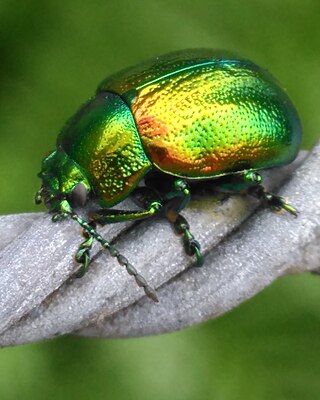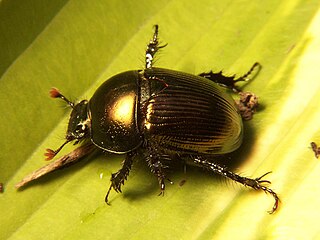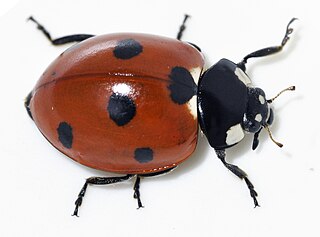
Beetles are insects that form the order Coleoptera, in the superorder Holometabola. Their front pair of wings are hardened into wing-cases, elytra, distinguishing them from most other insects. The Coleoptera, with about 400,000 described species, is the largest of all orders, constituting almost 40% of described insects and 25% of all known animal species; new species are discovered frequently, with estimates suggesting that there are between 0.9 and 2.1 million total species. Found in almost every habitat except the sea and the polar regions, they interact with their ecosystems in several ways: beetles often feed on plants and fungi, break down animal and plant debris, and eat other invertebrates. Some species are serious agricultural pests, such as the Colorado potato beetle, while others such as Coccinellidae eat aphids, scale insects, thrips, and other plant-sucking insects that damage crops. Some others also have unusual characteristics, such as fireflies, which use a light-emitting organ for mating and communication purposes.

The sap beetles, also known as Nitidulidae, are a family of beetles.

Volkswagen is a German automobile manufacturer based in Wolfsburg, Lower Saxony, Germany. Established in 1937 by the German Labour Front under the Nazi Party, it was revitalized into the global brand it is today after World War II by British Army officer Ivan Hirst. The company is well known for its iconic Beetle and serves as the flagship marque of the Volkswagen Group, which became the world's largest automotive manufacturer by global sales in 2016 and 2017.

The Volkswagen Beetle, officially the Volkswagen Type 1, is a small car produced by the German company Volkswagen from 1938 to 2003. One of the most iconic cars in automotive history, the Beetle is noted for its distinctive shape. Its production period of 65 years is the longest of any single generation of automobile, and its total production of over 21.5 million is the most of any car of a single platform.

Ground beetles are a large, cosmopolitan family of beetles, the Carabidae, with more than 40,000 species worldwide, around 2,000 of which are found in North America and 2,700 in Europe. As of 2015, it is one of the 10 most species-rich animal families. They belong to the Adephaga. Members of the family are primarily carnivorous, but some members are herbivorous or omnivorous.

The insects of the beetle family Chrysomelidae are commonly known as leaf beetles, and include over 37,000 species in more than 2,500 genera, making up one of the largest and most commonly encountered of all beetle families. Numerous subfamilies are recognized, but the precise taxonomy and systematics are likely to change with ongoing research.

The soldier beetles (Cantharidae) are relatively soft-bodied, straight-sided beetles. They are cosmopolitan in distribution. One of the first described species has a color pattern reminiscent of the red coats of early British soldiers, hence the common name. They are also known commonly as leatherwings because of their soft elytra.

The rove beetles are a family (Staphylinidae) of beetles, primarily distinguished by their short elytra that typically leave more than half of their abdominal segments exposed. With over 66,000 species in thousands of genera, the group is the largest family in the beetle order, and one of the largest families of organisms. It is an ancient group, with fossilized rove beetles known from the Triassic, 200 million years ago, and possibly even earlier if the genus Leehermania proves to be a member of this family. They are an ecologically and morphologically diverse group of beetles, and commonly encountered in terrestrial ecosystems.

The longhorn beetles (Cerambycidae), also known as long-horned or longicorns, are a large family of beetles, with over 35,000 species described.

The tansy beetle is a species of leaf beetle. The common name derives from its main foodplant, tansy, but it can also use other wetland plants such as gypsywort and water mint. It measures 7.7–10.5 mm in length and has a characteristic bright metallic green colouration, with pitted elytra and a coppery tinge. In addition to the nominotypical subspecies, which repeats the specific name, C. graminis graminis, there are five further distinct subspecies of tansy beetle, which, collectively, have a Palearctic distribution, although in the majority of countries where it is found the species is declining. In the United Kingdom it is designated as 'Nationally Rare'. The stronghold population here is located along the banks of the river Ouse in York, North Yorkshire. Other, small, fenland populations exist at Woodwalton Fen and at Welney Wildfowl and Wetlands Trust (WWT) reserve.

Harpalinae is the largest subfamily of ground beetles, containing more than 19,000 species worldwide.

Trogidae, sometimes called hide beetles, is a family of beetles with a distinctive warty or bumpy appearance. Found worldwide, the family includes about 300 species contained in four or five genera.

The mountain pine beetle is a species of bark beetle native to the forests of western North America from Mexico to central British Columbia. It has a hard black exoskeleton, and measures approximately 5 millimetres, about the size of a grain of rice.

Geotrupidae is a family of beetles in the order Coleoptera. They are commonly called earth-boring dung beetles or dor beetles. Most excavate burrows in which to lay their eggs. They are typically detritivores, provisioning their nests with leaf litter, but are occasionally coprophagous, similar to dung beetles. The eggs are laid in or upon the provision mass and buried, and the developing larvae feed upon the provisions. The burrows of some species can exceed 2 metres in depth.

A Practical Handbook of British Beetles ISBN 0-900848-91-X is a two-volume work on the British beetle fauna, by Norman H. Joy, first published by H. F. & G. Witherby in January 1932.
The British Entomological and Natural History Society or BENHS is a British entomological society. It is based at Dinton Pastures Country Park in Reading, England.

Ptiliidae is a family of very tiny beetles with a cosmopolitan distribution. They are colloquially called featherwing beetles, because the hindwings are narrow and feathery.

Coccinellidae is a widespread family of small beetles. They are commonly known as ladybugs in North America and ladybirds in the United Kingdom; "lady" refers to mother Mary. Entomologists use the names ladybird beetles or lady beetles to avoid confusion with true bugs. The more than 6,000 described species have a global distribution and are found in a variety of habitats. They are oval beetles with a domed back and flat underside. Many of the species have conspicuous aposematic (warning) colours and patterns, such as red with black spots, that warn potential predators that they taste bad.

Hygrobia is a genus of aquatic beetles native to Europe, North Africa, China and Australia. It is the only genus in the family Hygrobiidae, also known as the Paelobiidae. These are known commonly as squeak beetles or screech-beetles.

Phloiophilus edwardsii is the sole known species of the beetle family Phloiophilidae in the superfamily Cleroidea. It is native to Europe. The larvae are mycophagous, and have been observed feeding on basidiomycetes of the genus Phlebia growing on dead oak branches. The larvae are active during the winter period, before entering the soil to pupate in late spring-early summer.



















